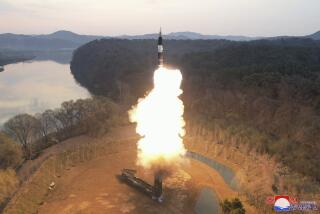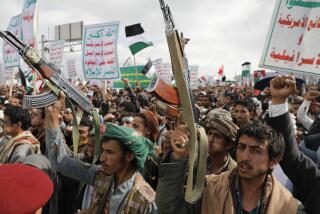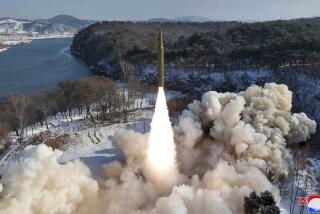Missile With Poison Gas Load Tested by Iraq
- Share via
WASHINGTON — The government of Iraqi President Saddam Hussein has successfully tested a chemical warhead loaded on an intermediate-range ballistic missile, adding a deadly new component to Baghdad’s military capability in the Mideast crisis, according to top U.S. and Arab officials.
The test provided the first demonstration that Iraq is capable of mounting a missile-borne poison gas attack against distant targets, including key U.S. and Saudi military installations as well as vital oil facilities, ports and cities in the region, the officials said.
Iraq’s three types of intermediate missiles have a range of 175 miles to almost 600 miles, enabling them to strike many vital military and civilian areas in northern and eastern Saudi Arabia.
Although officials said a successful chemical attack by missile would be difficult to execute, the weapons are considered more threatening than either artillery or aircraft loaded with mustard gas or nerve gas because of their range, speed and difficulty of interception.
During the final stages of the eight-year Iran-Iraq War, Baghdad’s extensive use of mustard and nerve gases against Iranian troops and use of missiles carrying conventional warheads against Iranian civilian areas were decisive factors in forcing Tehran to accept a U.N. cease-fire in 1988.
But Iraq did not merge missile technology with deadly poison gases, a combination characterized as a “doomsday” scenario, until after the war with Iran. No country has ever used a tactical ballistic missile loaded with the deadly toxins.
In a test monitored by Western intelligence last year, the Iraqi military successfully fired a chemical-loaded missile in northwest Iraq, a leading Arab official said.
Baghdad subsequently tried to strike a deal with Mauritania, a largely desert country in North Africa, to conduct further tests. But the deal was said to have fallen through in response to Western diplomatic pressure on Mauritania.
Although there have been no intelligence reports so far indicating that Iraq is planning large-scale chemical rocket attacks as part of any military action in the current crisis, U.S. military officials in the gulf already have made contingency plans.
U.S. forces have deployed a large but unspecified number of Patriot surface-to-air missiles in eastern and northern Saudi Arabia to intercept Iraqi missiles. The newly developed Patriots are the most advanced system in the U.S. arsenal, but they have never been deployed in combat.
Army officers who run the Patriot batteries in Saudi Arabia say they have specific plans for coping with chemically armed Iraqi missiles. They hope to intercept the incoming rockets at high altitude and disperse the poison gas so that it will be harmless to troops or civilians on the ground.
The U.S. contingent in the gulf also has deployed many of its most valuable aircraft, including F-117 Stealth fighters, F-15E attack planes and TR-1 and U-2 reconnaissance planes at remote Saudi airfields beyond the range of Iraqi missiles.
The Iraqis are known to have large quantities of Soviet Scud-B missiles with a 175-mile range. They also have hundreds of their own modified missiles: Al-Husseins with a range of 375 miles and Al-Abbases with a range of 575 miles. Baghdad, however, has only 36 launchers for its missiles, according to the International Institute of Strategic Studies.
Baghdad’s chemical weapons capability is among the most sophisticated in the world, with estimated annual production of 1,200 tons of chemical agents.
Iraq’s ballistic missiles, however, were described as “very inaccurate” by a senior U.S. Air Force official.
“They could be useful against an area target, but not against a high-value military target,” the official said. “One would want to deal with those early on (in any conflict). Some are mobile and difficult to keep up with. Others are fired from fixed sites, so they’re easier.”
A high-value military target is a small but strategically vital military asset, such as a radar installation, a group of parked aircraft, a troop ship or a command center. An area target could be an oil field, a city or a group of spread-out troops.
U.S. military officials generally minimize the potential effect of a chemical attack because American forces are well trained in anti-chemical procedures. The inaccuracy of the intermediate-range missile and the inherently unstable nature of the chemical warhead limit the odds of a successful strike.
Using a tactical ballistic missile loaded with chemical agents “is an extremely complicated and difficult operation because it requires that you have a mechanism that releases the gas at the right altitude as the missile is re-entering the atmosphere,” said Geoffrey Kemp, a former National Security Council staff member now at the Carnegie Endowment for International Peace.
“That is extremely precarious because it is dependent on climatic conditions, wind, temperatures and topography,” Kemp said.
U.S. military officials and private analysts said the primary threat is psychological rather than physical.
During Iraq’s missile attacks against Iranian cities, hundreds of thousands of people fled residential areas for the countryside or to cities beyond Iraq’s missile range, shutting down parts of the government and major businesses.
Civilian facilities in Saudi Arabia’s eastern Hasa province, such as Aramco’s oil installations and refineries at Dhahran, are particularly vulnerable to missile attack, U.S. officials concede. The psychological impact of a chemical weapons assault, even if missiles did not hit the complexes, could empty the area of the thousands of Saudi and foreign workers and paralyze the oil industry.
More to Read
Sign up for Essential California
The most important California stories and recommendations in your inbox every morning.
You may occasionally receive promotional content from the Los Angeles Times.










